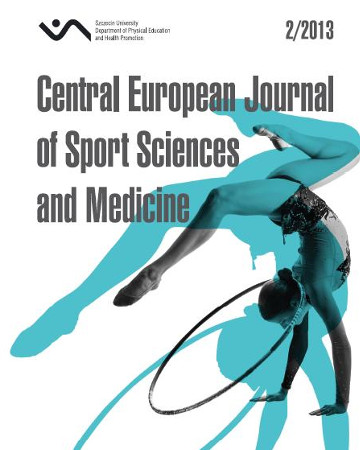
ISSN: 2300-9705
eISSN: 2353-2807
OAI




Lista wydań /
Vol. 2, No. 2/2013
EMG parameters and kinesthetic differentiation during the free-throw of basketball players with various levels of athletic experience
| Autorzy: |
Paweł
Pakosz
Opole University of Technology, Faculty of Physical Education and Physiotherapy |
| Słowa kluczowe: | Motor coordination capacities arm muscles electromyography (EMG) muscle bioelectrical activity level sports level |
| Data publikacji całości: | 2013 |
| Liczba stron: | 8 (31-38) |
Abstrakt
Rationale and objective of the study: In the study of coordination of motor abilities, motor performance tests without examining the internal structure of the movement were used. The objective of this study was to examine the kinesthetic differentiation capacity level and to stimulate muscles during a test among basketball players in intermediate and specialist stages of training. Material and methods: Among ten basketball players from two equal groups at different level of advancement in sport, who play at diffe rent positions on the field, kinesthetic differentiation capacity was assessed by the „Basketball shooting with different balls” test. In order to assess the muscle involvement during the test, they were connected to the EMG amplifier. Results: More advanced basketball players obtained better results in the test, by an average of 7.4 point out of 60. Tested muscle bioelectric tension was lower by 21.8% in advanced players and the difference in the non-dominant hand was as high as 34.6%. Conclusions: The research indicates that advanced players obtain better level of kinesthetic differentiation and their average muscle bioelectric tension during throws is lower compared to beginner players. The difference in bio-electrical muscle tension in the time of throwing different balls was smaller in basketball players who are more advanced in training, and in both groups in the dominant hand. Mean values of EMG signal in a selected time interval show greater variability among the more advanced players.
Pobierz plik
Plik artykułu
Bibliografia
| 1. | Blume D. D. Marking coordinative abilities and possibilities of development in the training process [in German]. Wissenschaftliche Zeitschrift der DHFK.1981;11(3):17 41. |
| 2. | Borysiuk Z., Zmarzły D. Surface electromyography (Semg) as a research tool of psychomotor reactions [in Polish]. Annales Universitatis Mariae Curie Skłodowska Lublin. 2005;60(16):188-192. |
| 3. | Borysiuk Z. Time structure of information processes in selected fighting sports [in Polish]. AWF Warszawa 2006. |
| 4. | Couzens G., Gandolifi G. Hoops! The Official National Basketball Players Association Guide to Playing Basketball. Mcgraw-Hill, New York 1987. |
| 5. | Hirtz P., Saaa H. The training in the sports games and the perfection of coordinative abilities [in German]. Körpererziehung. 1998;10:410-415. |
| 6. | Ji L., Huang B. A discussion on psychological characteristics of female ba¬sketball sharpshooters. Sport Science. 1987;7(2):61-64. |
| 7. | Knight B. Conditioning for the transition game. American Fitness Quarterly. 1984; 3: 44-49. |
| 8. | Konrad P. ABC of EMG. Practical introduction to kinesiological electromy¬ography [in Polish]. Technomex Spółka z o.o., Gliwice 2007. |
| 9. | Kubaszczyk A. Level of Coordinational Motor Abilities and Technical Skills of Basketball Players [in Polish]. Wychowanie Fizyczne i Sport. 2001;4:480-498. |
| 10. | Kuśnierz C. Lateralization and school performance in school children [in Polish]. Studia i Monografie OW Politechnika Opolska. 2004; 159. |
| 11. | Lambery S., Viaud-Delmon I, Berthoz A. Influence of a sensorimotor confilct on the memorization of a path traveled in virtual reality. Brain Res. Cogn. Brain Res. 2002;14(1):177-186. |
| 12. | Omorczyk J., Lyakh V. Dynamics of development of coordination motor abili¬ties by female students academy of physical education in Cracow . Young sports science of Ukraine. 2009;3: 122-128. |
| 13. | Popowczak M., Majorowski M., Cichy I., Kałużny K. The level of coordination motor abilities of students participating in the Basketmania program [in Polish]. Rozprawy Naukowe Akademii Wychowania Fizycznego we Wrocławiu. 2011;33:25 30. |
| 14. | Przewęda R., Wasilewski E. Motor learning [in Polish]. Roczniki Naukowe AWF w Warszawie. 1979;24:143-174. |
| 15. | Raczek J., Mynarski W., Ljach W. Shaping and diagnosing coordination motor abilities. Handbook for teachers, trainers and students [in Polish]. AWF Katowice 2002. |
| 16. | Raczek J. Coordination motor skills (theoretical and empirical base and the importance of sport) [in Polish]. Sport Wyczynowy. 1991;5-6:7-19. |
| 17. | Roth K., Winter R. Development of coordinative abilities [in German]. In G. & B. Ludwig (Hrsg.). Koordinative Fähigkeiten – koordinative Kompetenz. 2002: 97 103. |
| 18. | Salvatore M., Aglioti S., Cesari P., Romani M., Urgesi C. Action anticipation and motor resonance in elite basketball players. Nature Neuroscience. 2008;9:1109 1116. |
| 19. | Starosta W. The concept of modern training in sport. Studies in Physical Culture and Tourism. 2006;13(2):9-23. |
| 20. | Starosta W. The science of human movement in the system of physical education (sport) [in Polish]. Medycyna Sportowa. 2001;14(4):143-151. |
| 21. | Stefaniak T. Precision in recreation of the set power by combat sports athletes [in Polish]. Studia i Monografie AWF we Wrocławiu. 2008;90:62-72. |
| 22. | Stoeckel T., Weigelt M. Plasticity of human handedness: Decreased one-hand bias and inter-manual performance asymmetry in expert basketball players. Journal of Sports Sciences. 2012;30(10):1037-1045. |
| 23. | Zatoń M., Zatoń K., Zygadło A. Changes in kinesthetic differentiation capacity in the skiing learning process [in Polish]. Antropomotoryka. 2008;44:37-47. |
| 24. | Zimmermann K., Nicklisch R. Training coordinative skills and its importance for the technical and technical-tactical, capabilities of the athletes [in German]. The¬orie und Praxis der Körperkultur. 1981;10:764-768. |
| 25. | Zimmermann K. Essential coordination skills for sports games [in German]. Theorie und Praxis der Körperkultur. 1982;6:439-448. |